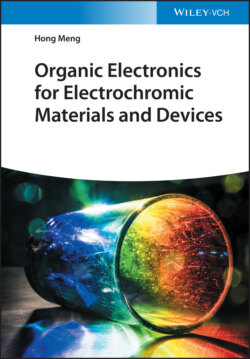Читать книгу Organic Electronics for Electrochromic Materials and Devices - Hong Meng - Страница 11
1 Introduction 1.1 General Introduction
ОглавлениеElectrochromism is the phenomenon that describes the optical (absorbance/transmittance/reflectance) change in material via a redox process induced by an external voltage or current [1]. Usually the electrochromic (EC) materials exhibit color change between a colored state and colorless state or between two colors, even multicolor. In nature, its origin is from the change of occupation number of material's internal electronic states. As the core of EC technology, the EC materials have built up many categories during decades of development, for example, according to the coloration type, it could be classified as anodically coloring materials (coloration upon oxidation) or cathodically coloring materials (coloration upon reduction) [2]. Based on the light absorption region in the solar radiation, which consists of these three parts: ultraviolet (UV), visible (Vis), and near‐infrared radiation (NIR) lights (Figure 1.1), it could be divided into visible EC materials (wavelength: 380–780 nm), which can be seen by the human eye and therefore are suitable for smart window and indicator applications, and NIR EC materials (wavelength: 780–2500 nm), which have great potential for thermal regulation technologies and even in national defense‐related applications [3]. And on the basis of materials species, there are mainly inorganic, organic, and hybrid EC materials [4, 5] (https://commons.wikimedia.org/wiki/File:Solar_spectrum_en.svg). Inorganic EC materials are transition metal oxides (TMOs) (WO3, NiO, TiO2, and Prussian Blue [PB]), organic EC materials including small molecules (e.g. viologen), conjugated polymers (e.g. poly(pyrrole), poly(thiophene), and poly(carbazole)) and aromatic polymers (e.g. polyimides [PIs] and polyamides [PAs]), organic–inorganic hybrid materials referring to metallo‐supermolecular polymers, and metal–organic framework (MOF). Among them, inorganic materials exhibit excellent long‐term stability compared with organic ones; however, considering the structure variety, flexibility, and low‐cost solution processability, organic EC materials are superior to inorganic materials. The organic–inorganic hybrid materials are designed to combine advantages of both organic and inorganic materials.
Figure 1.1 Solar irradiance spectrum above atmosphere and at the surface of the Earth.
Source: Nick84: https://commons.wikimedia.org/wiki/File:Solar_spectrum_en.svg, Licensed under CC BY‐SA 3.0.
EC materials exhibit color changes during the redox process; therefore the electrochromic devices (ECDs) generally consist of three elements: electrodes, EC materials, and electrolyte solution. The electrodes offer a constant supply of electric current, and ions are conducted by the electrolyte solution. Then the EC materials undergo electrochemical oxidation and/or reduction, which results in changes in the optical bandgap and colors. As shown in Figure 1.2, a typical ECD has five layers: two transparent conducting oxide (TCO) layers, EC layer, ion‐conducting layer (electrolyte solution), ion storage layer. Particularly, the ion storage layer acts as the “counter electrode” to store ions and keep electric charge balance. And according to the exact state of EC materials, there are three types of ECD: film type (I), solution type (II), and hybrid type (III). The Type I ECD is the most common; many kinds of EC materials are suitable for this type including TMOs, conjugated/non‐conjugated polymers, metallo‐supermolecular polymers, and MOF/covalent organic framework (COF) materials, which using spin‐coating, spray‐coating, and dip‐coating processes to form uniform films; these films won't dissolute in electrolyte solutions. Type II ECD requires that the EC materials have good solubility in electrolyte solutions. Therefore many organic small molecules such as viologen, terephthalate derivatives, and isophthalate derivatives are appropriate for this type of device. Meanwhile the fabrication method for this type of device is the most simple one. It just needs to dissolve the electrolyte and EC material in a specific solvent and inject into the prepared conducting cell. Type III ECD uses film‐type EC materials as working electrode and solution‐type EC materials as ion storage layer.
Figure 1.2 The scheme of three types of electrochromic devices.
